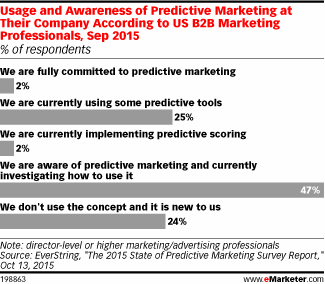John Wannamaker would have liked marketing automation.
Loved it, in fact.
[This is the second part in our series focusing on the Mar Tech ecosystem.]
Wannamaker, the revolutionary 19th century New York merchant, is famously purported to have declared in desperation, “Half the money I spend on advertising is wasted; the trouble is I don’t know which half.”
Today, money is still being wasted in advertising and marketing – and a good deal of time as well. And that amounts to about the same thing if you believe that time is money.
Their capacity for saving time – and by extension, money – in a variety of ways is the main factor that has propelled automation platforms to the top of many marketers’ wish list of technical solutions.
Lead nurturing, audience segmentation, CRM integration, real-time analytics and drip/trigger marketing campaign capabilities are just a few of the features that have fueled the popularity of automated solutions like InfusionSoft, Act-On, Marketo, and HubSpot.
With so much to offer, it’s no wonder that the number of organizations implementing marketing automation has increased exponentially since 2011 and the range of options to choose from has exploded as well.
And yet despite this rapid adoption, there is still vast room for growth. In fact, the overall market penetration for marketing automation solutions remains pitifully low, hardly above 10% even among enterprises with yearly revenue over $5 billion and even lower among small- and medium-sized businesses.
So what’s going on here?
Increased Efficiency for All
There is no denying that marketing automation platforms offer great opportunities for improving efficiency, which is a boon especially for small businesses – but not only – who have limited resources, tighter budgets and less margin for error when it comes to unproductive marketing efforts.
Most, if not all, of the major players on the automation landscape offer solutions for streamlining repetitive tasks and speeding up processes, especially when it comes to email campaigns. The main elements include:
- Integration with CRM data to personalize emails.
- A/B testing for enhanced optimization
- Drip/trigger campaigns to push email and content at regular intervals. These can be based on customer behavior (triggers) and/or previous customer behavior.
Combine this with support for content creation and publishing (blogs/landing pages) and SEO optimization and it’s not hard to see why “all-in-one” platforms like HubSpot and Marketo have become popular for inbound marketing with small and medium businesses.
Yet when it comes to the more advanced options of marketing automation – lead management and analytics – there seems to be some difficulty.
Exploiting Customer Engagement with Marketing Automation
Far more than being just a tool to streamline repetitive tasks, automation platforms offer marketers complex lead management capabilities which have proven to be extremely effective for increasing sales opportunities:
- Lead tracking: charting a lead’s reaction to content at various stages of the marketing funnel and track points of disengagement.
- Lead nurturing: personalization of drip/trigger campaigns based on previous behaviour and optimizing the customer experience throughout their journey.
- Lead scoring: measuring a lead’s readiness and providing built-in alerts when leads take the next step through the marketing funnel.
Combined with real-time analytics to measure content and advertising effectiveness, these capabilities have great potential for boosting customer engagement.

This in addition to even greater efficiency:
- Conversion attribution gives both marketing and sales teams a clear idea of what content influences leads and helps them focus their efforts more closely on those areas that provide the best ROI.
Instead of wasting time pushing mass content/offers that have little or no effect on potential customers, it is possible to increase customer engagement, capitalize on up-selling opportunities, while avoiding wasted time on leads that are less likely to convert. - Lead management significantly increases the cooperation and synchronization between sales and marketing teams. Automatic alerts allow leads to be passed seamlessly from the marketing funnel to the sales pipeline, again saving time and effort.
So with improved efficiency and effectiveness that would have made John Wannamaker jealous, marketing automation platforms would seem to be just the thing. Then what is holding it back?
The Good and Bad of Segmentation
The answer is connected to one word – segmentation.
One of the main selling points of popular platforms like Marketo, ActOn, Oracle’s Eloqua and others is that they should allow marketers to do everything in one place. Content creation, landing page creation, blogging, social media campaigns as well as lead management – the appeal of total control, ease-of-use and smooth utility is obvious.
However, a large number of marketers who have already implemented automated solutions indicate that they feel they aren’t getting enough out of their platform.
This is due in large part to a lack of integration in marketing technologies within companies – in other words, data and platforms being siloed, preventing full marketing mobilization across the board.
This echoes the findings of a recent CMO Council report which revealed, among other things, that customer data remains unaligned and unaggregated and therefore less useful in generating revenue.
Ideally, automation should address these issues and make it easier for marketers to leverage data gathered from a variety of to better engage and convert potential customers.
This kind of segmentation – using real-time analytics to divide potential customers into different categories and target them with more individualized messages – is the single most valuable method for improving conversion rates.
So for larger enterprises the challenge is to successfully integrate their cumbersome legacy technologies which have left marketing and sales and customer relations with siloed data that is difficult to activate.
For smaller companies, a frequent lack of technical know-how leaves them using only the more basic functions of their automation platforms without being to fully harness their potential. This also explains why automated solutions have only a 3% adoption rate among non-tech related companies.
An Open-Ended Future
Will marketing automation continue to expand despite these challenges?
If the past is any indication, the answer is yes. Especially given the potential for revenue for automation vendors – over $1.5 billion in 2015 and real value their platforms provide plus the vast number of businesses that have yet to implement automated solutions.
While it remains an elusive calculation at best, value is at the heart of what marketing automation offers. Time and money saved equals increased ROI and that’s something that is hard to ignore.
There is likely to be some consolidation among marketing automation vendors in the future, following the trend of years past. (Adobe’s acquisition of Neolane and Oracle’s purchase of Eloqua and Responsys are just two examples.)
But as the need grows across different business sectors and companies look to integrate their current technologies with platforms that meet their specific needs, the market will continue to grow.
Marketing agencies too will play a part in future growth as they look to diversify their offerings and make themselves more attractive with integrated technology and services.
Predictive Marketing on the Rise
One area that is sure to fuel greater expansion in automation is predictive marketing.
This directly answers the needs highlighted in the CMO report – only 5 percent of marketers feel confident enough to adapt and clearly predict customer journey and determine which actions will provide maximum value.

More and more companies are recognizing the value of predictive technology and as the demand grows so will the market.
Its growth will be tied closely to the ability to gather and analyse customer data, fueling even more demand for the integration of data management platforms (DMP) and tag management systems (such as open-source solution 7tag) to make them effective.
Some progress has already been made on the predictive front. Adobe’s Analytics platform offers features such as anomaly detection to track trends, audience clustering to aid in segmentation and customer propensity modeling to maximize campaign value.
Another example is Lattice Engines, a solution providing predictive modeling and preferred by giants such as VMWare and PayPal.
Mature Marketing
As marketing and marketing automation move farther into the new millennium, the range of options continues to grow, as do the challenges to success. But then – no one ever said it would be easy.
More than a hundred years after John Wannamaker made a name for himself in New York City, technology is closer than ever to delivering marketers the answers and solutions they need to save themselves time and money.
If they will accept them.








